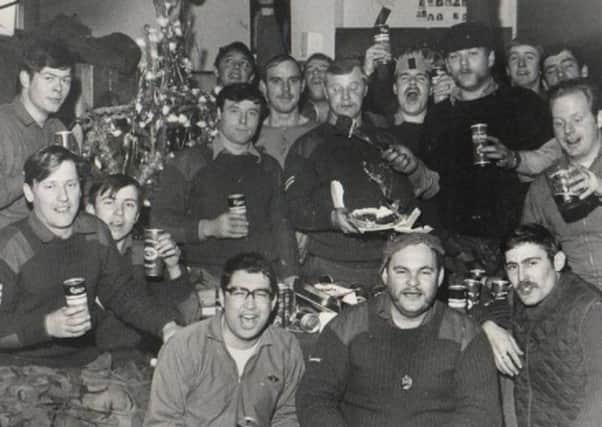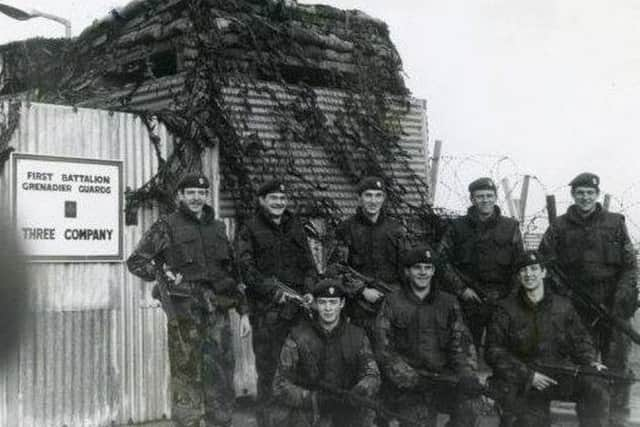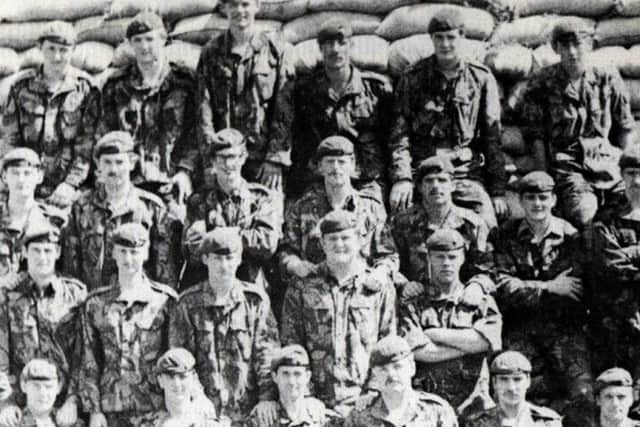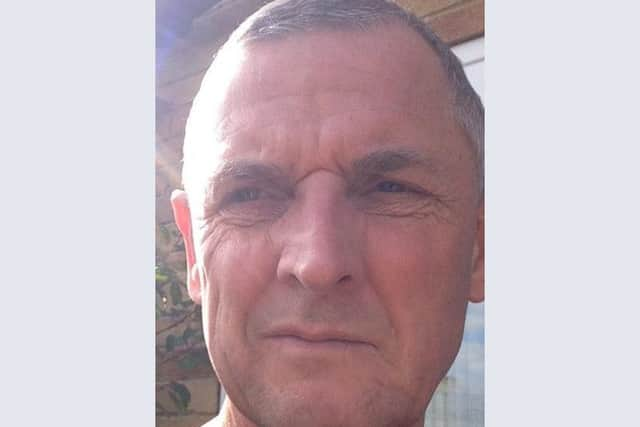‘I would have joined the IRA’ - former Northamptonshire soldier


Mick Corbett is a former private in the Grenadier Guards and was stationed on two occasions in Creggan.
His first tour between November 1972 and March 1973 saw him placed at a post at the former Essex factory on Bligh’s Lane.
Advertisement
Hide AdAdvertisement
Hide AdAnd, between March and July, 1974, he was stationed at the British army encampment at Piggery Ridge on the upper edge of the Creggan estate.
Mr Corbett told our sister paper the Derry Journal that he has spent the years after leaving the army reassessing what he encountered in Ireland.
“I am a Northamptonshire lad and grew up on the farm for the first few years of my life. I joined the army in 1971 for a bit of adventure and signed up for six years. I was stationed in Germany first and I arrived in Ireland aged 19,” he said.
The dedicated presence of the British Army in Creggan came after Operation Motorman on July 31, 1972, when the military moved en masse to stop the ‘no go’ areas of Derry. The operation, of which the Derry part was referred to as Operation Carcan, saw the army establish bases inside St Peter’s and St Joseph’s schools at either end of Creggan.
Advertisement
Hide AdAdvertisement
Hide AdOn the morning of Operation Motorman, two teenagers were shot dead by the British Army in the estate. They were 15-year-old Daniel Hegarty and 19-year-old Seamus Bradley. Prior to this of course, Bloody Sunday had enraged the nationalist community and swelled the ranks of the IRA.


All this ensured that the initial period when nationalists welcomed the army and referred to by the British army’s General Officer in Command, Sir Ian Freeland as the ‘honeymood period’ was most definitely long over.
Mick Corbett said: “On the first tour things weren’t too bad. People on the street at least spoke or acknowleged you. There was a bit of shooting and of course rioting but no one in our ranks was killed. I remember an incident from the first tour. On my first patrol along Creggan Broadway, I encountered a small child of about two, who was crawling along the pavement close to the kerb. when he saw us he pulled a nasty face, raised his little hand a made a V sign.
“I was stunned. I couldn’t understand the mentality that instilled such hatred in the mind of someone so young. I thought that if kids were raised in an atmosphere like that, what hope was there for the future?”
Advertisement
Hide AdAdvertisement
Hide AdThe ‘Journal’ asked the former soldier what however, he had been told about the history and politics of Ireland, Derry, the local population and what to expect before his arrival?


If I had been born in Creggan I know I would have joined the IRA-Mick Corbett
“We were told that this was an internal security matter within the UK. That it was between Catholics and Protestants and that was it. We learned the rest from the television news and picked it up as we went along.
“We knew nothing at all about Creggan. That would have helped. I hadn’t a clue about the extent Protestants had abused their power over Catholics through gerrymandering in employment, housing, policing and the administration of government. “To my eternal regret I was also naive enough to believe the Widgery report and the Paras account of Bloody Sunday. I now know it was a total whitewash,” he said.
Advertisement
Hide AdAdvertisement
Hide AdPiggery Ridge became a focal point for attacks by the IRA and local youths throughout its existence. It was also used as an interrogation centre by the military for republican suspects detained by the British Army.


In 1977, the ‘Journal’ reported that the Derry Brigade of the IRA accused the British army of using children to gather information by taking them to the camp on the premise of allowing them to use the football pitch, but whilst there showing them photographs of suspects.
A statement from the IRA said: “This demonstrates the depths to which the British war machine will go to collect information and it is our hope that the parents will put an effective end to this scurrilous practice by simply warning their children about any invitations from soldiers to visit the camp,” the statement said.
“This area is, and always has been, a prime target and we sincerely hope that we will have the full co-operation of the parents of the area in safe-guarding their children.”
Advertisement
Hide AdAdvertisement
Hide AdThe British Army denied the claims saying that they had held a fun and games day at the camp for eight children.
“Before the youngsters left, they were given photographs which had been taken earlier in the afternoon showing themselves taking part in the games. At no stage were any of the children shown photographs for identification purposes,” they said.
Mick Corbett’s company commander at the time was a Major Manners who is still remembered with notoriety by people of the Creggan community to this day. This officer despite the obvious dangers presented by the IRA in the area insisted of walking around the estate in attempt to speak to locals. His efforts in the attempted ‘winning of hearts and minds’ however proved fruitless.
“He would walk around and try to talk to people in order to get information. Some of those officers lived on another planet. The mannerisms that they used, the way that they spoke was alien. There were definite class distinctions at work,” said Mick.
Advertisement
Hide AdAdvertisement
Hide AdHe also said that life inside Piggery Ridge was at times a pressure cooker situation.
“On the second tour it was a lot different. You could cut the atmosphere with a knife. It was a constant round of patrolling-in and out of the camp all the time. There were riots and shootings and bombings. There were 27 of us billeted in a make-shift cabin at the height of summer. I spoke years later to a guy who was just 15-years-old when he was shooting at us. He said after the shooting they would strip down the parts of the Armalite and the local girls would take them away.”
As if it were needed by this point, proof of the heightening of tension came when Mick recalled that a local dog in Creggan who the soldiers let into the Piggery Ridge camp and fed regularly was later found cut to pieces in the area having been deemed a ‘traitor’ to the republican cause.
“Somedays it was just very quiet and that’s when you knew something was going to happen because there was no one on the streets. I couldn’t wait to leave the place after the second tour,” said the former Grenadier Guard.
Advertisement
Hide AdAdvertisement
Hide AdAnother incident recalled by Mick Corbett from his first tour was the death of nine-year-old Gordon Gallagher in his own back yard in Leenan Gardens when he triggered an IRA landmine meant for British soldiers who had begun to patrol through gardens on the hunt for weapons and explosives. Gordon Gallagher was playing cowboys and indians when he was killed in 1973.
“We were all sickened. For days afterwards I remember his dad staring out the window as if in a void. All of us were terribly upset. But, it wasn’t until I lost my first daughter from a terminal illness that I recalled and began to understand Mr and Mrs Gallagher’s tragic loss.”
From 1976 right up until 1993, the Grenadier Guards lost six members of the regiment to IRA actions in the North. The most highlighted member of their ranks killed was Captain Robert Nairac who had been seconded to the SAS to work undercover. In January 1976, he was abducted and murdered by the IRA in South Armagh. His remains have never been recovered.
Despite the toll takenLovely, tanks. on his former colleagues, Mick Corbett says that since he left the army he has spent many years reassessing his time here. By his own admission it has been a “long process”. After taking redundancy from his job as a landscape gardener he turned to studying for a degree which included examination of the conflict both here and around the world.
Advertisement
Hide AdAdvertisement
Hide Ad“It gave me a lot more understanding and a different perspective and empathy. If I had been born in Creggan I know I would have joined the IRA. “
Mick Corbett returned to Ireland after the beginning of the peace process. “It captured my imagination, especially the huge moves made by Sinn Fein, that I felt compelled to go back to Derry and have a look around. What a difference there was. There were no barricades, army posts or patrols. The Creggan looked smart and tidy.
“I went into a shop near the Rosemount RUC barracks and thought about the monotonous hours spent stopping and checking cars on the sandbagged checkpoint and when a new lad who was just 18 and straight from the training depot, picked up a booby trapped metal detector and it blew up in his hand.
“The shops at Central Drive where they shot at us were gone and they’d shot a sergeant and blew another man up. I remembered the fear when I was trapped by a crowd who spat and screamed at me and flats at Cromore were gone. That’s where I fired my first shot in anger after being shot at.”
Advertisement
Hide AdAdvertisement
Hide Ad“I have made peace with it now, it’s a very personal thing. I wanted to go see the Bloody Sunday graves. I still attend army reunions and they are not very many like me who feel the way I do now. It’s resulted in a few arguments,” he said.
Recalling late night and very early morning stints in the British army sanger at Bligh’s Lane, Mick Corbett finally said: “I remember looking out at the views over Derry, Lough Foyle and the north west. It’s beautiful country. I’m glad I went back to Ireland. It has all added up in the end. It’s been a very personal journey.”